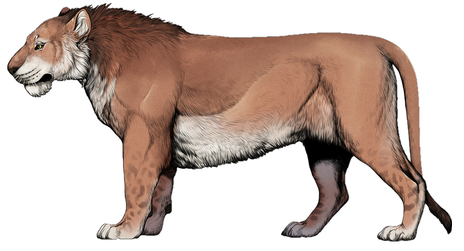|
Sangamonian Stage
The Sangamonian Stage (or Sangamon interglacial) is the term used in North America to designate the Last Interglacial (130,000-115,000 years ago) and depending on definition, part of the early Last Glacial Period, corresponding to Marine Isotope Stage 5 (~130-80,000 years ago). While often historically considered equivalent in scope to MIS 5, it is now often used in a more narrow sense to refer to the Last Interglacial only (corresponding to MIS 5e and the European Eemian). It preceded the Wisconsinan (Wisconsin) Stage and followed the Illinoian Stage in North America. Definition The Sangamonian Stage, originally the Sangamon interglacial stage, is defined on the basis of the Sangamon Soil, a paleosol, which is developed in contemporaneous colluvium and older glacial tills and loesses and overlain by Wisconsinan loesses or tills. Although originally described from water wells in northwestern Sangamon County, Illinois, the current type sections for the Sangamon Stage are the Roch ... [...More Info...] [...Related Items...] OR: [Wikipedia] [Google] [Baidu] |
North America
North America is a continent in the Northern Hemisphere, Northern and Western Hemisphere, Western hemispheres. North America is bordered to the north by the Arctic Ocean, to the east by the Atlantic Ocean, to the southeast by South America and the Caribbean Sea, and to the south and west by the Pacific Ocean. The region includes Middle America (Americas), Middle America (comprising the Caribbean, Central America, and Mexico) and Northern America. North America covers an area of about , representing approximately 16.5% of Earth's land area and 4.8% of its total surface area. It is the third-largest continent by size after Asia and Africa, and the list of continents and continental subregions by population, fourth-largest continent by population after Asia, Africa, and Europe. , North America's population was estimated as over 592 million people in list of sovereign states and dependent territories in North America, 23 independent states, or about 7.5% of the world's popula ... [...More Info...] [...Related Items...] OR: [Wikipedia] [Google] [Baidu] |
Canada
Canada is a country in North America. Its Provinces and territories of Canada, ten provinces and three territories extend from the Atlantic Ocean to the Pacific Ocean and northward into the Arctic Ocean, making it the world's List of countries and dependencies by area, second-largest country by total area, with the List of countries by length of coastline, world's longest coastline. Its Canada–United States border, border with the United States is the world's longest international land border. The country is characterized by a wide range of both Temperature in Canada, meteorologic and Geography of Canada, geological regions. With Population of Canada, a population of over 41million people, it has widely varying population densities, with the majority residing in List of the largest population centres in Canada, urban areas and large areas of the country being sparsely populated. Canada's capital is Ottawa and List of census metropolitan areas and agglomerations in Canada, ... [...More Info...] [...Related Items...] OR: [Wikipedia] [Google] [Baidu] |
Pleistocene North America
The Pleistocene ( ; referred to colloquially as the ''Ice Age'') is the geological epoch that lasted from to 11,700 years ago, spanning the Earth's most recent period of repeated glaciations. Before a change was finally confirmed in 2009 by the International Union of Geological Sciences, the cutoff of the Pleistocene and the preceding Pliocene was regarded as being 1.806 million years Before Present (BP). Publications from earlier years may use either definition of the period. The end of the Pleistocene corresponds with the end of the last glacial period and also with the end of the Paleolithic age used in archaeology. The name is a combination of Ancient Greek () 'most' and (; Latinized as ) 'new'. The aridification and cooling trends of the preceding Neogene were continued in the Pleistocene. The climate was strongly variable depending on the glacial cycle, oscillating between cold glacial periods and warmer interglacials, with the sea levels being up to lower than ... [...More Info...] [...Related Items...] OR: [Wikipedia] [Google] [Baidu] |
Middle Pleistocene
The Chibanian, more widely known as the Middle Pleistocene (its previous informal name), is an Age (geology), age in the international geologic timescale or a Stage (stratigraphy), stage in chronostratigraphy, being a division of the Pleistocene Epoch within the ongoing Quaternary Period. The Chibanian name was officially ratified in January 2020. It is currently estimated to span the time between 0.7741 annum, Ma (774,100 years ago) and 0.129 Ma (129,000 years ago), also expressed as 774.1–129 ka. It includes the transition in palaeoanthropology from the Lower Paleolithic, Lower to the Middle Paleolithic over 300 ka. The Chibanian is preceded by the Calabrian (stage), Calabrian and succeeded by the Late Pleistocene. The beginning of the Chibanian is the Brunhes–Matuyama reversal, when the Earth's magnetic field last underwent reversal. Its end roughly coincides with the termination of the Penultimate Glacial Period and the onset of the Last Interglacial period (correspondin ... [...More Info...] [...Related Items...] OR: [Wikipedia] [Google] [Baidu] |
Glaciology Of The United States
Glaciology (; ) is the scientific study of glaciers, or, more generally, ice and natural phenomena that involve ice. Glaciology is an interdisciplinary Earth science that integrates geophysics, geology, physical geography, geomorphology, climatology, meteorology, hydrology, biology, and ecology. The impact of glaciers on people includes the fields of human geography and anthropology. The discoveries of water ice on the Moon, Mars, Europa and Pluto add an extraterrestrial component to the field, which is referred to as "astroglaciology". Overview A glacier is a persistent body of dense ice, a form of rock) formed from snow falling and accumulating over a long period of time; glaciers move very slowly, either descending from high mountains, as in valley glaciers, or moving outward from centers of accumulation, as in continental glaciers. Areas of study within glaciology include glacial history and the reconstruction of past glaciation. A glaciologist is a person who studies g ... [...More Info...] [...Related Items...] OR: [Wikipedia] [Google] [Baidu] |
Timeline Of Glaciation
There have been five or six major ice ages in the history of Earth over the past 3 billion years. The Late Cenozoic Ice Age began 34 million years ago, its latest phase being the Quaternary glaciation, in progress since 2.58 million years ago. Within ice ages, there exist periods of more severe glacial conditions and more temperate conditions, referred to as glacial periods and interglacial periods, respectively. The Earth is currently in such an interglacial period of the Quaternary glaciation, with the Last Glacial Period of the Quaternary having ended approximately 11,700 years ago. The current interglacial is known as the Holocene epoch.Walker, M., Johnsen, S., Rasmussen, S. O., Popp, T., Steffensen, J.-P., Gibbard, P., Hoek, W., Lowe, J., Andrews, J., Bjo¨ rck, S., Cwynar, L. C., Hughen, K., Kershaw, P., Kromer, B., Litt, T., Lowe, D. J., Nakagawa, T., Newnham, R., and Schwander, J. 2009Formal definition and dating of the GSSP (Global Stratotype Section and Point) for ... [...More Info...] [...Related Items...] OR: [Wikipedia] [Google] [Baidu] |
Ice Age
An ice age is a long period of reduction in the temperature of Earth's surface and atmosphere, resulting in the presence or expansion of continental and polar ice sheets and alpine glaciers. Earth's climate alternates between ice ages, and greenhouse periods during which there are no glaciers on the planet. Earth is currently in the ice age called Quaternary glaciation. Individual pulses of cold climate within an ice age are termed '' glacial periods'' (''glacials, glaciations, glacial stages, stadials, stades'', or colloquially, ''ice ages''), and intermittent warm periods within an ice age are called '' interglacials'' or ''interstadials''. In glaciology, the term ''ice age'' is defined by the presence of extensive ice sheets in the northern and southern hemispheres. By this definition, the current Holocene epoch is an interglacial period of an ice age. The accumulation of anthropogenic greenhouse gases is projected to delay the next glacial period. History of research ... [...More Info...] [...Related Items...] OR: [Wikipedia] [Google] [Baidu] |
Panthera Spelaea
''Panthera spelaea'', commonly known as the cave lion (or less commonly as the steppe lion), is an extinct ''Panthera'' species that was native to Eurasia and northwest North America during the Pleistocene epoch. Genetic analysis of ancient DNA has revealed that while closely related, it was a distinct species genetically isolated from the modern lion (''Panthera leo''), with the genetic divergence between the two species estimated at around 500,000 years ago. The earliest fossils of the ''P. spelaea'' lineage (either regarded as the separate species ''Panthera fossilis'' or the subspecies ''P. spelaea fossilis'') in Eurasia date to around 700,000 years ago (with possible late Early Pleistocene records). It is closely related and probably ancestral to the American lion (''Panthera atrox''). The species ranged from Western Europe to eastern Beringia in North America, and was a prominent member of the mammoth steppe fauna, and an important apex predator across its range along wit ... [...More Info...] [...Related Items...] OR: [Wikipedia] [Google] [Baidu] |
American Lion
The American lion (''Panthera atrox'' (), with the species name meaning "savage" or "cruel", also called the North American lion) is an extinct pantherine cat native to North America during the Late Pleistocene from around 129,000 to 12,800 years ago. Genetic evidence suggests that its closest living relative is the lion (''Panthera leo''), with the American lion representing an offshoot from the lineage of the largely Eurasian cave lion (''Panthera spelaea''), from which it is suggested to have split around 165,000 years ago. Its fossils have been found across North America, from Canada to Mexico. It was about 25% larger than the modern lion, making it one of the largest known felids to ever exist, and a dominant apex predator in North American ecosystems, alongside the sabertooth cats '' Smilodon'' and ''Homotherium''. It has been suggested, like modern lions, they were social animals, although this is not known for sure. The American lion became extinct as part of the end ... [...More Info...] [...Related Items...] OR: [Wikipedia] [Google] [Baidu] |
Rancholabrean
The Rancholabrean North American Land Mammal Age on the geologic timescale is a North American faunal stage in the North American Land Mammal Ages chronology (NALMA),Sanders, A.E., R.E. Weems, and L.B. Albright III (2009) Formalization of the mid-Pleistocene "Ten Mile Hill beds" in South Carolina with evidence for placement of the Irvingtonian–Rancholabrean boundary, ''Museum of Northern Arizona Bulletin'' 64:369-375 named after the famed Rancho La Brea fossil site (more commonly known as the La Brea tar pits) in Los Angeles, California.Savage, D.E. (1951) Late Cenozoic vertebrates of the San Francisco Bay region, ''University of California Publications, Bulletin of the Department of Geological Sciences'' 28:215-314 The Rancholabrean is characterized by the presence of the genus ''Bison,'' which appeared in northwestern North America during the Illinoian (globally known as the Penultimate Glacial Period or Marine Isotope Stage 6) around 190-130,000 years ago, before becoming es ... [...More Info...] [...Related Items...] OR: [Wikipedia] [Google] [Baidu] |
Bison Latifrons
''Bison latifrons'', also known as the giant bison or long-horned bison, is an extinct species of bison that lived in North America during the Late Pleistocene epoch ranging from southern Canada to Mexico. It is noted for its large body size and its distinctive long horns. Description Because only skulls and horns of this species have been found well preserved, the size of ''B. latifrons'' is currently not clearly known. Based on leg bones, the mass of ''B. latifrons'' has been estimated to be 25-50 percent larger than that of modern ''B. bison'', making it undoubtedly one of the largest-ever ruminants. The known dimensions of the species are on average larger than any extinct and extant bovids, including both the American bison and the European bison, making it the largest known bovid. Overall, it was probably around in length and stood about or up to tall at the withers. With an estimated weight of to , ''B. latifrons'' was one of the largest ruminants ever, rivaled in mass ... [...More Info...] [...Related Items...] OR: [Wikipedia] [Google] [Baidu] |








